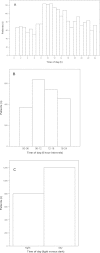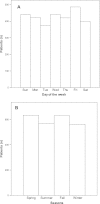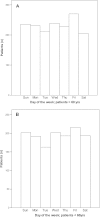Circadian and weekly variation and the influence of environmental variables in acute myocardial infarction
- PMID: 22733558
- PMCID: PMC3430762
- DOI: 10.1007/s12471-012-0297-3
Circadian and weekly variation and the influence of environmental variables in acute myocardial infarction
Abstract
Objectives: The aim of our study was to investigate the circadian and weekly variation and assess the influence of environmental variables on the occurrence of acute myocardial infarction (AMI).
Methods: Our study population consisted of 2983 consecutive patients admitted with AMI between January 2006 and May 2008. Data were abstracted from hospital records and partially from an electronic database. In patients with a known time of onset of AMI, circadian variation was analysed. In all patients, weekly variation of onset of AMI was analysed. Information on daily mean temperature, sunny hours, rainy hours, maximal humidity and mean atmospheric pressure was obtained from the KNMI database and the influence of these environmental variables on the incidence of AMI was analysed.
Results and conclusion: Incidence of AMI shows a circadian pattern with an increase in occurrence during daylight. AMI occurs equally on each day of the week and no relation was found between environmental variables and the occurrence of AMI.
Figures



Similar articles
-
Influence of climatic variables on acute myocardial infarction hospital admissions.Int J Cardiol. 2009 Oct 2;137(2):123-9. doi: 10.1016/j.ijcard.2008.06.036. Epub 2008 Aug 9. Int J Cardiol. 2009. PMID: 18694607
-
Circadian Variation In The Onset Of Acute Myocardial Infarction In Diabetics.J Ayub Med Coll Abbottabad. 2018 Jan-Mar;30(1):71-73. J Ayub Med Coll Abbottabad. 2018. PMID: 29504334
-
Circadian and weekly variations in pain onset of acute myocardial infarction.Zhonghua Yi Xue Za Zhi (Taipei). 1999 Jun;62(6):334-40. Zhonghua Yi Xue Za Zhi (Taipei). 1999. PMID: 10389290
-
The timing of infarction pain in patients with acute myocardial infarction after previous revascularization.ScientificWorldJournal. 2008 Jun 13;8:598-603. doi: 10.1100/tsw.2008.88. ScientificWorldJournal. 2008. PMID: 18604443 Free PMC article. Review.
-
Daylight saving time and myocardial infarction: should we be worried? A review of the evidence.Eur Rev Med Pharmacol Sci. 2018 Feb;22(3):750-755. doi: 10.26355/eurrev_201802_14306. Eur Rev Med Pharmacol Sci. 2018. PMID: 29461606 Review.
Cited by
-
Short-Term Changes in Weather Conditions and the Risk of Acute Coronary Syndrome Hospitalization with and without ST-Segment Elevation: A Focus on Vulnerable Subgroups.Medicina (Kaunas). 2024 Mar 9;60(3):454. doi: 10.3390/medicina60030454. Medicina (Kaunas). 2024. PMID: 38541180 Free PMC article.
-
Physiological equivalent temperature and hospitalized due to respiratory and cardiovascular diseases in Dezful, Iran.Heliyon. 2025 Feb 18;11(4):e42763. doi: 10.1016/j.heliyon.2025.e42763. eCollection 2025 Feb 28. Heliyon. 2025. PMID: 40066054 Free PMC article.
-
Influence of daily individual meteorological parameters on the incidence of acute coronary syndrome.Int J Environ Res Public Health. 2014 Nov 12;11(11):11616-26. doi: 10.3390/ijerph111111616. Int J Environ Res Public Health. 2014. PMID: 25396770 Free PMC article.
-
Prediction of emergency department presentations for acute coronary syndrome using a machine learning approach.Sci Rep. 2024 Oct 4;14(1):23125. doi: 10.1038/s41598-024-73291-1. Sci Rep. 2024. PMID: 39367080 Free PMC article.
-
Circadian onset and prognosis of myocardial infarction with non-obstructive coronary arteries (MINOCA).PLoS One. 2019 Apr 25;14(4):e0216073. doi: 10.1371/journal.pone.0216073. eCollection 2019. PLoS One. 2019. PMID: 31022242 Free PMC article.
References
-
- Willich SN, Klatt S, Arntz HR. Circadian variation and triggers of acute coronary syndromes. Eur Heart J. 1998;19 Suppl C:C12–C23. - PubMed
LinkOut - more resources
Full Text Sources

